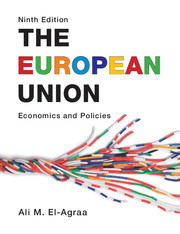Book contents
- Frontmatter
- Contents
- Figures
- Tables
- Boxes
- Contributors
- Preface
- A reader’s guide
- Abbreviations
- 1 General introduction
- Part I EU history, institutions and legal dimension
- Part II EU market integration
- 6 The theory of economic integration
- 7 The economics of the single market
- 8 Factor mobility
- 9 Measuring the economic impact of European integration
- Part III EU monetary integration
- Part IV The single European market
- Part V EU budget and structural policies
- Part VI EU external relations
- Part VII The future of the EU
- Bibliography
- Author Index
- Index
- References
8 - Factor mobility
from Part II - EU market integration
- Frontmatter
- Contents
- Figures
- Tables
- Boxes
- Contributors
- Preface
- A reader’s guide
- Abbreviations
- 1 General introduction
- Part I EU history, institutions and legal dimension
- Part II EU market integration
- 6 The theory of economic integration
- 7 The economics of the single market
- 8 Factor mobility
- 9 Measuring the economic impact of European integration
- Part III EU monetary integration
- Part IV The single European market
- Part V EU budget and structural policies
- Part VI EU external relations
- Part VII The future of the EU
- Bibliography
- Author Index
- Index
- References
Summary
Introduction
Although the freedom of mobility of labour and capital were objectives enshrined in the Treaty of Rome itself, only fairly limited progress had been made by the early 1980s in turning this into reality. Most countries had capital controls of one form or another, and labour faced considerable constraints on movement through lack of recognition of qualifications and other problems over establishment and transfer of benefits. The slow progress stemmed from two sources. In the case of capital, member states (MSs) were worried that having free movement would lead to destabilizing flows that would disturb the running of the domestic economy. The main fear was a capital outflow that would depreciate the currency, drive up the rate of inflation and require monetary and fiscal contraction to offset it. Labour controls, on the other hand, were more concerned with inflows. Employees in the domestic economy feared that an inflow from other countries would lose them their jobs – countries would export their unemployment. Much of this was dressed up as a need to have certain skills, standards and local knowledge for the protection of consumers. Much of the fear stemmed from ignorance of what others’ qualifications meant, and overcoming this required a long and tedious process of determination and negotiation.
This chapter begins by exploring the role of the movement of capital and labour in the EU and the history of its development, before moving on: first, to study capital mobility, and direct investment in particular; and then labour mobility.
- Type
- Chapter
- Information
- The European UnionEconomics and Policies, pp. 114 - 125Publisher: Cambridge University PressPrint publication year: 2011



